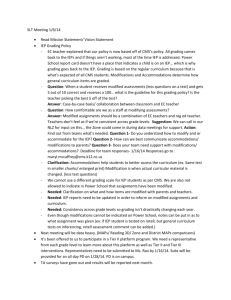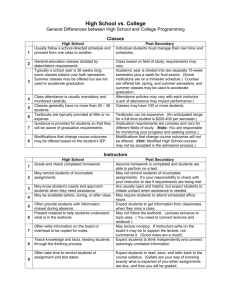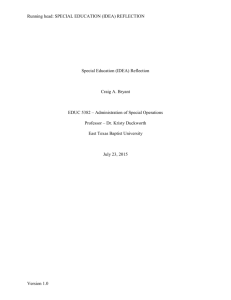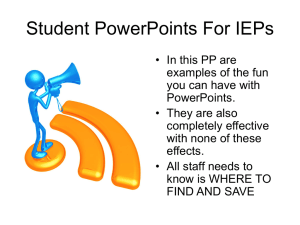Field Experience - Tennessee State University
advertisement
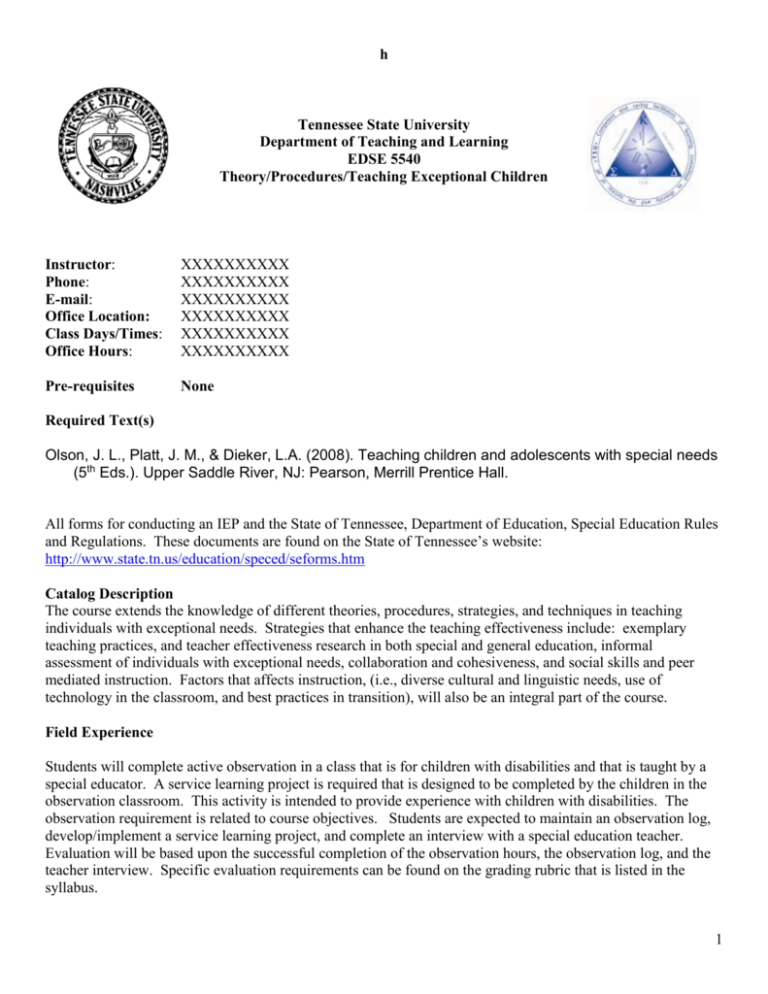
h Tennessee State University Department of Teaching and Learning EDSE 5540 Theory/Procedures/Teaching Exceptional Children Instructor: Phone: E-mail: Office Location: Class Days/Times: Office Hours: XXXXXXXXXX XXXXXXXXXX XXXXXXXXXX XXXXXXXXXX XXXXXXXXXX XXXXXXXXXX Pre-requisites None Required Text(s) Olson, J. L., Platt, J. M., & Dieker, L.A. (2008). Teaching children and adolescents with special needs (5th Eds.). Upper Saddle River, NJ: Pearson, Merrill Prentice Hall. All forms for conducting an IEP and the State of Tennessee, Department of Education, Special Education Rules and Regulations. These documents are found on the State of Tennessee’s website: http://www.state.tn.us/education/speced/seforms.htm Catalog Description The course extends the knowledge of different theories, procedures, strategies, and techniques in teaching individuals with exceptional needs. Strategies that enhance the teaching effectiveness include: exemplary teaching practices, and teacher effectiveness research in both special and general education, informal assessment of individuals with exceptional needs, collaboration and cohesiveness, and social skills and peer mediated instruction. Factors that affects instruction, (i.e., diverse cultural and linguistic needs, use of technology in the classroom, and best practices in transition), will also be an integral part of the course. Field Experience Students will complete active observation in a class that is for children with disabilities and that is taught by a special educator. A service learning project is required that is designed to be completed by the children in the observation classroom. This activity is intended to provide experience with children with disabilities. The observation requirement is related to course objectives. Students are expected to maintain an observation log, develop/implement a service learning project, and complete an interview with a special education teacher. Evaluation will be based upon the successful completion of the observation hours, the observation log, and the teacher interview. Specific evaluation requirements can be found on the grading rubric that is listed in the syllabus. 1 Course Proficiencies (*Course proficiencies are based on the seven (7) Key Performance Areas which have identified by the Professional Education Unit. The complete listing of Key Performance Areas is available at www.tnstate.edu/coeweb -> student resources -> key performance areas.) (Content Knowledge, Skills, Dispositions) Content Knowledge KS1. Plan: Design and implement instructional plans that reflect sound content knowledge and include meaningful learning for all, utilizing appropriate technology and accommodating diverse needs. KS2. Maximize Learning: Encourage critical thinking, problem solving, active inquiry, and cultural pluralism; and differentiate learning opportunities for diverse needs, using human, literary, and technology resources effectively. KS4. Manage: Competently apply theory to create a caring, positive and productive learning environment, facilitated by technology and with sensitivity to diversity. KS5. Model Professionalism. Demonstrate professional ethics, standards, and responsibilities, including respect for diversity; pursue service and professional growth opportunities, and use technology effectively. Dispositions D1. Plan: Value learners’ experiences and strengths as a basis for growth and their errors as learning opportunities. D2. Maximize Learning: Provide quality education to all learners, encourage critical thinking and self efficacy, and believe in and help all to succeed. D4. Manage: Maintain a positive and productive learning environment that also both encourages and protects learners. D5. Model Professionalism: Consistently demonstrate caring, fairness, responsibility, professional dress and behaviors, appropriate interactions, professional standards and ethics, commitment to service, and respect for all learners and constituents 2 Lecture Discussion Laboratory Exercises Exhibits/Displays Technology (instructor) Technology (students) Case Studies Field Experience Instructional Strategies Classroom lectures on theories, and strategies of teaching exceptional children; web-enhanced lectures; in-depth training of IEP development Chapter discussion, Web-based discussion; guest speaker; discussion of the strategies of IEP development None Students are required to exhibit/display a quality lesson plan in class; Students are trained to develop an IEP for children with disabilities in the Web-enhanced discussion; On-line instruction; Course information posting online, on-line syllabus On-line participation; web-based research, electronic assignment submission Classroom Analysis; and Final Exam Case Studies Log/Diary/Journal On-site field-based participant observation in different counties in elementary and secondary areas Observation Log Portfolio None Individual Presentations Lesson Presentation using own lesson plan Interactive classroom discussion of chapters; Classroom activity Group Discussions Group Presentations Report/Paper Students are assigned in groups to teach a lesson in a simulated inclusive lesson in class One Research paper, One Abstract Paper REQUIREMENTS ARTIFACTS, SCORING RUBRIC FOR KEY ASSESSMENTS FOR THIS COURSE 1. Field Experience/observation: Level II: Teacher-directed experiences in school/ classrooms (or service learning settings) for which candidates are not expected to prepare in advance INDICATOR 5.B: Engages in high-quality, on-going professional development as defined by the Tennessee State Board of Education Professional Development Policy to strengthen knowledge and skill in the content of the teaching assignment. INDICATOR 5.C: Performs professional responsibilities efficiently and effectively. Field based participation/observation and one teacher interview is required from an inclusion based classroom settings. Observation must include but not limited to five individual students with disabilities and participate in 3 some activities with each student as directed and supervised by the cooperating teacher. Observation must include details description of the inclusive teaching and classroom environment, collaboration with other teachers and community, students’ activity and the teaching methods and strategies that are compatible with the theoretical knowledge, skills, and practices. All students must follow the reflection 1 & 2 criteria. (100 points), (Follow the Matrix Guideline and Please include the grading rubric with your assignment): Reflection #1:, Describe the situation you have observed to include the location of the school/setting, type of classroom, number of children and adults, subjects taught during your period of observation, etc. The length of this paper should be at least 2 pages. Describe five students and what drew you to him or her. Reflect on the teacher/counselor, student, or other students’ behavior toward the student. Do not generate solutions yet. Reflect on questions, concerns, and things you want to watch as you spend more time in the classroom. Remember, the reflection one is not a critique of someone’s teaching. Include at least five concerns or questions which you will investigate for the next reflection report. The answers to your questions should come from your observation teacher or from the dynamics of the classroom/setting. Reflection #2: Describe how your perceptions of the child, teacher and others have changed or remained the same since you learned more about helping children with disabilities or the disability or problem encountered. Look back at your first report; were your perceptions correct or incorrect, why? Reflect on the reasons for these changes. How will you handle the unique needs of a student of this type or how will you handle your own perceptions. In the research component, do not just add quotes from other people or from your text book. Weave these ideas in to support your experiences or to suggest alternatives. Examine the strategies that are being used in the classroom. Find at least one journal article that support your observation or provide additional strategies that may be helpful. Interweave summaries of the article into your report and attach copies of the article that you used. Using APA format, summarize information from the textbook concerning the disability of focus in your paper. You may support what you have been observing or find articles that may indicate a different method or strategy for proving instruction. Reflect on how this research may be useful in this classroom or with this student. This report should be at least 4 pages in length. It should also include a reference page with APA style citations and a copy of the article that you used. Teacher interviews (include the attached survey) Field Observation Grading Criteria Name ______________ Expected Criteria Total Points 100 Observation Log from cooperating teachers & their comment on your participation and professionalism (signed and dated) Classroom description Classroom observation of 10 Semester____________ Points earned Observation Dates School/Agency And contact Names and Phone # Comments and signature by Cooperating Teacher one at the end of the observation Comments and signature by Cooperating Teacher two 30 4 Teaching strategy and technique implementation into the instructional process Description of five students and an explanation of the teaching benefit to each students Typed Summary with personal reflection and future recommendation with adequate research sources Interview from one teacher. Include questionnaire and typed summary 20 20 20 2 Two IEP’s are required. KS1; D1; Key Assignment IEP’s will be written on two case studies, one elementary and one high school. At least one case must be obtained from your field observation. The IEP can be developed and written as you observe the needs and the present level of performance of the observant. The goals and objectives will be developed based on individual need. It will be discussed and exercised in class. IEP will include all 7 categories including background information of the case. (60+40= 100 points) Criteria Case Description with area of need Description of Present level of Performance Description of goals of objectives with assessment provision Description of transition plan Total Points 5 points Points Earned Comments 15 points 20 points 10 points (for high school only) 60 for IEP 2 40 for IEP 1 3. Select two areas of disabilities. Gather articles from the special education/and other journals in the related field. Write a comparative paper discussing how your selected studies discussed the importance and the application of different theoretical approach in developing special education knowledge skills and practice for children with disabilities in today’s classrooms. The paper must begins with an abstract, at least eight pages in length in the body of illustrations not including the title page, and the reference page. The paper must contain at least 10 current references (within the past five years). One of the references could be the textbook for the course. Please use APA format for citations. There is an abbreviated guide to 5 APA on-line at www.wnmu.org/support/apa.htm. Papers that are plagiarized will be assigned a zero grade and will be reported. Paper must be written in APA format. And must follow the Rubric guidelines (100 points). Please include the grading rubric with your assignment. 100 points RESEARCH PAPER RUBRIC Abstract References in side the (15 Points) text: 10 Articles and Textbook (10 Points) Reference Page (5 Points) APA (10 Points) Length: 7+ Pages- Not including title page, abstract, or reference page (5 Points) Overall Content (60 Points) Total: 100 4. Students will select a theme and develop a lesson that can be taught to ALL students in inclusive settings. The presentation will include but not limited to: Detailed written lesson plan with goals, objectives, activity, materials, and evaluation implementing instructional strategies and techniques Research information Collaboration with other teachers, parent/family involvement, and other community organization Technology incorporation Multicultural/bilingual issue Modification Creativity and originality will be credited. (100 points) Please include the grading rubric with your assignment): Lesson Plan Presentation Grading Criteria Name ______________ Expected Criteria Grade Level, Area of need (must explain the individual needs in details) Theme (description, clarity) Purpose, objectives Materials (handouts, technology incorporation, etc) Activity ( actual teaching incorporating theories and models that taught in the class) Variety Collaboration (community, parent, and others) Research (references to support your Semester______________ Total Points 100 10 Points earned Comments 10 5 10 40 10 5 6 purpose) Originality Total 10 100 Acceptable Unacceptable Target INDICATOR 5.C: Performs professional responsibilities efficiently and effectively. 5. Midterm, Five (100 points: 5 X 20) essay questions. 20 Points each is divided by Topic knowledge & discussion in details with example 10 points Written organization 5 points Classroom connection 5 points INDICATOR 7.B: Demonstrates knowledge, skills, and dispositions in field of study. 6. Take Home Final Exam (20X5=100 points) on 5 case study analysis Case analysis: Intervention strategies with examples of inclusive classrooms Research Support 5points 10 points 5 points 7. Disposition: Classroom participation, discussion, attendance, professionalism =50 points GRADING Field Observation report: Two IEP’S Research Paper Lesson Presentation Two Exams Disposition Total: 100 points 100 points 100 points 100 points 200 points 50 points ---------650 points Each assignment will be graded on a point basis and a letter grade assigned according to the following scale: A = 585-650 90-100% B = 520-584 80-89%, C= 455-519 70-79%, F= 454-below 60-69%. Portfolio Information () Not Required Expectations and General Information: 7 1) Academic Integrity - You are responsible for what you achieve in this class; therefore neither cheating nor plagiarism will be tolerated. Any material taken from another work must be documented, and in no case should one represent another’s work as one’s own, this includes information received from others during examinations or submitting another’s assignments, papers, etc. as one’s own. Students involved in collaborative research, to avoid questions of plagiarism, should exercise extreme caution. If in doubt, students should check with the major professor. In addition to the other possible disciplinary sanctions which may be imposed through the regular institutional procedures as a result of academic misconduct, the instructor has the authority to assign an “F” or a zero for the exercise or examination, or to assign an “F” in the course. I will use Google to determine whether or not a paper violates academic honesty. 2) Classroom conduct – The instructor has the primary responsibility for control over classroom behavior and maintenance of academic integrity, and can order temporary removal or exclusion from the classroom of any student engaged in disruptive conduct or conduct in violation of the general rules and regulations of the institution. 3) Official Course Enrollment - Students who are not on the official class roll may not remain in class. These students must leave class and may not return to class until they enroll in the course and their names show up on the official class roster. Please make sure you are in the correct section. 4) Disabled Student Services – Any student who has a condition which might interfere with his/her performance in class is required to contact the office of Disabled Student Services. This office is located in room #117 Floyd Payne Student Center. The phone number is 963-7400. They will provide you with a document stating what type of classroom accommodations, if any, are to be made by the instructor. The student is to give a copy of this document to the instructor no later than the end of the second week of class. Failure to do so will result in the instructor making no special accommodations of any kind. 5) Attendance and participation are required. Excessive absences will affect your final grade. Being late or leaving early on a regular basis will affect your final grade. Any Unexcused absences will result in 10% lower of the Final grade. 6) All assignments (except observation journal) should be computer generated (doubled spaced). Handwritten work will not be accepted. The observation journal should be complete, legible and easy to read. Points are deducted for incomplete journal logs. 7) Changes in the syllabus: The instructor reserves the right to make whatever changes needed to protect the integrity of the course and to make maximum advantage of unplanned learning opportunities. 8) Copies of Assignments: Each student is responsible for maintaining copies of all completed assignments. Because humans and computers are not error-proof, I advise that you save often when writing papers, and once completed, save one copy to disk and one as a hard copy. Make sure that you have copies of anything that you send using the email to include documentation of the date that the material was sent. Any assignment that involves article summaries should have copies of the article attached. 9) Classroom Civility and Code of Conduct: Please be conscious of how your behavior contributes to, or detracts from, creating a respectful and professional learning environment. Further, many of the course discussions draw from personal experience. Remember that you are always in control of the depth and degree of personal information you disclose. It is important that we all agree not to disclose what other students share in class without their permission 10) Late Assignments: All required assignments should be typed and turned in at the beginning of class on the date assigned. Assignments turned in after this time will be considered late. Late assignments will be accepted only one day after the due date. However, the assignment will be reduced one grade level from the final grade. (These points cannot be made up through revisions). Assignments will not be accepted that are more than one day late. If you are absent when an assignment is due, it is your responsibility to send, deliver, email, or FAX your assignment, or turn it in the following day. Do not wait until the next class to turn in your work, as this will substantially decrease your grade. Exams missed because of an emergency must be made up within one week of the scheduled date for the exam. All due dates and exams are not subject to change without involvement of a group process. 8 11) Use of Phones, Pagers, and Other Signaling Devices: Refrain from receiving calls or pages during class sessions. It is the responsibility of the student to insure that all sound-emitting devices are maintained on the off position. Additional Readings/Resources There are excellent references list at the end of the textbook. Addition references: Gredler, M.E.(2008). Learning and instruction: Theory into practice. (6th Ed.) Upper Saddle River, NJ: Pearson, Merrill Prentice Hall. Polloway, E. A.., Patton, J. R., & Serna, L. (2001). Strategies for teaching learners with special needs. (7th Ed.) Upper Saddle River, NJ: Pearson, Merrill Prentice Hall. 9

